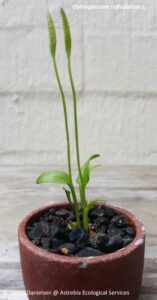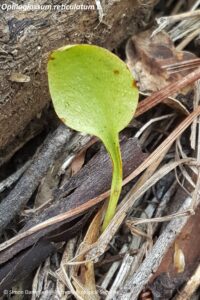The world of plants is truly amazing – I recently became aware for the first time of a genus that has been literally under my feet for years – the tongue ferns or Ophioglossum spp.!
 I first became aware of these tiny ferns when they began popping up in my hanging plant pots! Soon I had a whole colony, and they transplanted well into tiny bonsai pots, although I had no idea what they were – there were only tiny, fairly non-descript leaves with blades about 10-15 mm long.
I first became aware of these tiny ferns when they began popping up in my hanging plant pots! Soon I had a whole colony, and they transplanted well into tiny bonsai pots, although I had no idea what they were – there were only tiny, fairly non-descript leaves with blades about 10-15 mm long.
Finally, fruiting spikes emerged and they revealed their identity as ferns!
 Those pictured here are Ophioglossum reticulatum L. (Ophioglossaceae), a tiny fern growing to 20 cm or so tall, and recorded from damp, shady situations among grass or on bare soil, often in eucalypt forest.
Those pictured here are Ophioglossum reticulatum L. (Ophioglossaceae), a tiny fern growing to 20 cm or so tall, and recorded from damp, shady situations among grass or on bare soil, often in eucalypt forest.
This species has been collected from Melbourne to the northern tip of Cape York Peninsula and west to Broome – it also occurs in New Zealand and in tropical and sub-tropical countries throughout the world.
It was first described by the father of taxonomy Carl Linnaeus in 1762 in his Species Plantarum.
 The fruiting spikes (actually modified leaves) are shown in this image – they are approximately 5 cm tall, and their presence mark the members of Ophioglossaceae as quite different from other ferns – they are referred to by taxonomists as either fern allies or fern ‘oddities’.
The fruiting spikes (actually modified leaves) are shown in this image – they are approximately 5 cm tall, and their presence mark the members of Ophioglossaceae as quite different from other ferns – they are referred to by taxonomists as either fern allies or fern ‘oddities’.
This is because most ferns have the seed-bearing organs, or sporangia, arranged on the underside of the leaves/fronds. In the Ophioglossaceae, the sporangia are placed at the apex of a specialised leaf or fruiting spike.
Another distinctive feature of ferns not shared by Ophioglossum spp. is that their leaves do not unfurl – they merely lengthen from the rhizome.
 I also recorded this species on a survey I conducted in 2018 on the Evelyn Tablelands, growing on basaltic soil in Eucalyptus tereticornis open forest.
I also recorded this species on a survey I conducted in 2018 on the Evelyn Tablelands, growing on basaltic soil in Eucalyptus tereticornis open forest.
Superficially, they looked very similar (but smaller) to the Typhonium praetermissum I had been surveying in the Darwin region a few months earlier.
 These tiny leaves were barely noticeable among the leaf litter, but were spotted by my eagle-eyed mate Dave Hunter, whose curiosity and ability to pick out tiny orchids and other cyrptophytes is fast becoming legendary!
These tiny leaves were barely noticeable among the leaf litter, but were spotted by my eagle-eyed mate Dave Hunter, whose curiosity and ability to pick out tiny orchids and other cyrptophytes is fast becoming legendary!

https://shorturl.fm/SFocM
https://shorturl.fm/zMBwU
https://shorturl.fm/tX9l7
https://shorturl.fm/N24JY
https://shorturl.fm/jWZq2
Can you be more specific about the content of your article? After reading it, I still have some doubts. Hope you can help me.
https://shorturl.fm/gX8pK
Your point of view caught my eye and was very interesting. Thanks. I have a question for you.
https://shorturl.fm/DYPL9
https://shorturl.fm/0IgvZ
https://shorturl.fm/05vot
https://shorturl.fm/wMKxN
Thank you for your sharing. I am worried that I lack creative ideas. It is your article that makes me full of hope. Thank you. But, I have a question, can you help me? https://www.binance.com/en-IN/register?ref=UM6SMJM3
E aí, galera! Pra quem tá chegando agora no SSS Games 2, o login é super tranquilo, viu? Sem complicação! Acessem logo e bora jogar! login
Thank you for your sharing. I am worried that I lack creative ideas. It is your article that makes me full of hope. Thank you. But, I have a question, can you help me?
Your point of view caught my eye and was very interesting. Thanks. I have a question for you. https://accounts.binance.info/en-IN/register?ref=UM6SMJM3
https://shorturl.fm/u9U8s
https://shorturl.fm/ZP4gp
Thank you for your sharing. I am worried that I lack creative ideas. It is your article that makes me full of hope. Thank you. But, I have a question, can you help me? https://www.binance.info/es-MX/register-person?ref=JHQQKNKN
https://shorturl.fm/qtVLm
https://shorturl.fm/5iJhD
Thanks for sharing. I read many of your blog posts, cool, your blog is very good.
https://shorturl.fm/gNW8U
https://shorturl.fm/QORXl
Your article helped me a lot, is there any more related content? Thanks!
https://shorturl.fm/tOb8M
https://shorturl.fm/PwJUv
https://shorturl.fm/ol521
Your article helped me a lot, is there any more related content? Thanks!
https://shorturl.fm/6guLd
https://shorturl.fm/hOItQ
https://shorturl.fm/tTPzN
https://shorturl.fm/CmocS
Your point of view caught my eye and was very interesting. Thanks. I have a question for you.
https://shorturl.fm/VHDFv
https://shorturl.fm/8DLbP
https://shorturl.fm/qeNHR
https://shorturl.fm/np7ND
https://shorturl.fm/9fb3E
https://shorturl.fm/PHjii
I don’t think the title of your article matches the content lol. Just kidding, mainly because I had some doubts after reading the article. https://www.binance.info/en-IN/register-person?ref=UM6SMJM3
https://shorturl.fm/M9VRd
https://shorturl.fm/osSDd
Thanks for sharing. I read many of your blog posts, cool, your blog is very good.
https://shorturl.fm/Aa0YS
https://shorturl.fm/wKIY7
Reading your article has greatly helped me, and I agree with you. But I still have some questions. Can you help me? I will pay attention to your answer. thank you.
https://shorturl.fm/40ex9
I don’t think the title of your article matches the content lol. Just kidding, mainly because I had some doubts after reading the article.
https://shorturl.fm/lSTFu
I believe this site has got some real superb info for everyone : D.
Thanks for sharing. I read many of your blog posts, cool, your blog is very good.
https://shorturl.fm/SZDR7
https://shorturl.fm/8d0lV
https://shorturl.fm/433vk
https://shorturl.fm/vfw7u
https://shorturl.fm/IU2TP
https://shorturl.fm/VsVg1
https://shorturl.fm/zCJnZ
Thank you for your sharing. I am worried that I lack creative ideas. It is your article that makes me full of hope. Thank you. But, I have a question, can you help me?
https://shorturl.fm/xSdBf
Thanks for sharing. I read many of your blog posts, cool, your blog is very good.
I don’t think the title of your article matches the content lol. Just kidding, mainly because I had some doubts after reading the article.
https://shorturl.fm/v7Td1
I went over this web site and I think you have a lot of wonderful information, saved to bookmarks (:.
I don’t think the title of your article matches the content lol. Just kidding, mainly because I had some doubts after reading the article. https://www.binance.info/bg/register?ref=V2H9AFPY
Your article helped me a lot, is there any more related content? Thanks!
https://shorturl.fm/TOBHL
Thanks for sharing. I read many of your blog posts, cool, your blog is very good. https://www.binance.info/register?ref=IXBIAFVY
Your article helped me a lot, is there any more related content? Thanks! https://www.binance.info/register?ref=IHJUI7TF